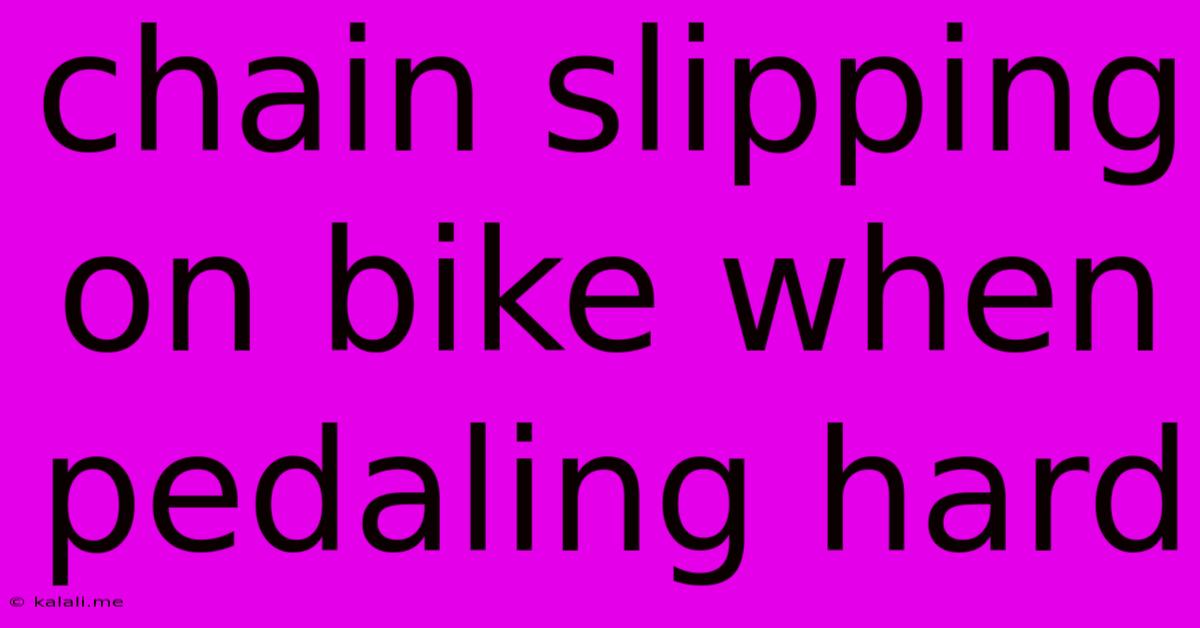Chain Slipping On Bike When Pedaling Hard
Kalali
Jun 02, 2025 · 3 min read

Table of Contents
Chain Slipping on Your Bike: Causes and Solutions
Are you experiencing frustrating chain slippage while pedaling hard on your bike? This common cycling problem can disrupt your ride and even lead to accidents. This article will delve into the common causes of chain slippage and provide practical solutions to get you back on the road smoothly. Understanding why your chain slips is the first step to fixing the issue and enjoying a more efficient and enjoyable ride.
Why is my bike chain slipping? Chain slippage often occurs due to several interconnected factors, including worn components, incorrect adjustments, and even environmental conditions. Let's explore the most frequent culprits:
Worn-Out Cassette and Chainring Teeth
Over time, the teeth on your cassette (rear cogs) and chainrings (front cogs) wear down, becoming rounded and less effective at gripping the chain. This gradual wear is unavoidable with regular use, and when the teeth are significantly worn, the chain is more likely to skip. Inspect your cassette and chainrings closely; worn teeth will appear rounded or hooked, rather than sharp and pointed.
Stretched Chain
A stretched chain is a common cause of chain slippage. Regular use causes the chain's rollers to wear and the links to elongate, making it difficult for the chain to engage properly with the cassette and chainrings. A simple visual check can often reveal a stretched chain. If the chain appears slack or droops significantly between the chainrings, it's likely stretched and needs replacement.
Incorrect Derailleur Adjustment
Your derailleurs (front and rear) are crucial for precise chain shifting. If your derailleurs are improperly adjusted, the chain may not sit correctly on the cassette or chainring, causing it to slip. Incorrect cable tension, limit screws, or derailleur hanger alignment can all contribute to this problem.
Dirty or Lubricated Chain
A dirty chain, clogged with grime and grit, won't grip the teeth properly. Similarly, excessive lubrication can attract dirt and create a slippery surface. Regular cleaning and lubrication with a high-quality chain lubricant is essential for optimal performance and longevity.
Bent Derailleur Hanger
The derailleur hanger is a small, often overlooked component that mounts the rear derailleur to the frame. A bent derailleur hanger can misalign the derailleur, resulting in inconsistent shifting and chain slippage. Inspect the derailleur hanger for any bends; even minor bends can significantly impact performance.
Cross-Chaining
Cross-chaining refers to using the largest front chainring with the smallest rear cog, or vice-versa. This creates significant chain angles, putting excess stress on the drivetrain and increasing the likelihood of chain slippage. Avoid cross-chaining whenever possible; shifting to a more central combination will reduce chain angles and improve drivetrain efficiency.
Low Chain Tension
If your chain is too loose, it may not have enough tension to engage the cassette and chainrings correctly. Ensure your chain tension is within the manufacturer's specifications.
How to Fix Chain Slippage
Addressing chain slippage involves a multi-step approach. Here’s what you can do:
- Inspect your chain, cassette, and chainrings: Look for worn or damaged teeth. Replace any components that are severely worn.
- Check your chain for stretch: Use a chain checker tool to measure the chain's elongation. Replace it if it exceeds the manufacturer's recommended stretch limit.
- Clean and lubricate your chain: Regularly clean your chain with a degreaser and then lubricate it with a suitable chain lubricant.
- Adjust your derailleurs: Properly adjust your derailleurs, ensuring correct cable tension, limit screws, and shifting performance.
- Inspect your derailleur hanger: Check for bends and replace if necessary.
- Avoid cross-chaining: Shift to a more central chainring and cog combination for optimal performance.
Addressing these issues will significantly improve the performance of your bike's drivetrain, leading to smoother, more efficient pedaling and a more enjoyable ride. Remember that preventative maintenance is key; regular cleaning, lubrication, and inspection of your drivetrain components will help you avoid many common cycling problems.
Latest Posts
Latest Posts
-
And All The Kings Horses And All The Kings Men
Jun 04, 2025
-
Can I Use Instant Pudding Instead Of Cook And Serve
Jun 04, 2025
-
How To Write Maiden Name And Married Name
Jun 04, 2025
-
Symptoms Of No Coolant In Car
Jun 04, 2025
-
Saints Row 3 Map Gang Operations
Jun 04, 2025
Related Post
Thank you for visiting our website which covers about Chain Slipping On Bike When Pedaling Hard . We hope the information provided has been useful to you. Feel free to contact us if you have any questions or need further assistance. See you next time and don't miss to bookmark.